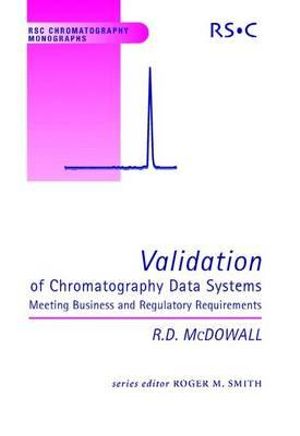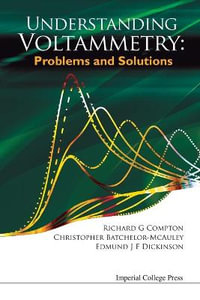
Validation of Chromatography Data Systems
Meeting Business and Regulatory Requirements
By: Robert McDowall
Hardcover | 7 February 2005
At a Glance
290 Pages
24.77 x 16.51 x 2.54
Hardcover
$422.75
or 4 interest-free payments of $105.69 with
orAims to ship in 10 to 15 business days
Chromatography is a major analytical technique that is used throughout research, development and manufacturing in the pharmaceutical, medical device and associated industries. To demonstrate fitness for purpose with the applicable regulations, the systems must be validated.
Validation of Chromatography Data Systems introduces the basics of computer validation. It looks in detail at the requirements throughout the life cycle of a CDS for any regulated laboratory, from its concept, through writing the user requirements specification to selecting the system, testing and operational release, including using electronic signatures. This logical and uniquely organised book provides the background to the regulatory requirements, interpretation of the regulations and documented evidence needed to support a claim that a system is validated. Development of the system, risk management, operation and finally system retirement and data migration are discussed. Case studies and practical examples are provided where appropriate.
Validation of Chromatography Data Systems is ideal for the chromatographer working in analytical laboratories in the regulated pharmaceutical, contract research, biotechnology and medical device industries seeking the practical guidance required for validating their chromatography data systems in order to meet regulatory requirements. It will also be welcomed by consultants or those in regulatory agencies.
Industry Reviews
| List of Figures | p. xx |
| List ofTables | p. xxii |
| Glosarry | p. xxiv |
| Abbreviations | p. xxvii |
| How to Use this Book | p. 1 |
| Purposeand Scope | p. 1 |
| The Way It Was | p. 2 |
| The Way It Should Be | p. 2 |
| Book Structure: Life to Death of a CDS | p. 2 |
| Chapter Structure | p. 3 |
| Understanding the Basics | p. 5 |
| Planning the Work | p. 5 |
| Selecting the System | p. 6 |
| Installingand Testing the System | p. 6 |
| Support and Release of the System | p. 7 |
| Maintaining the Validation and Upgrading the System | p. 7 |
| Data Migration and System Retirement | p. 7 |
| Retrospective Validation of a CDS | p. 8 |
| Use Your Organisation's Computer Validation Policy | p. 8 |
| Assumptions,Exclusions and Limitations | p. 8 |
| Introduction to Chromatography Data Systems | p. 9 |
| What is a Chromatography Data System? | p. 9 |
| Typesof Chromatography Data System | p. 9 |
| Naming Conventions | p. 11 |
| Method Files | p. 11 |
| Instrument Control Files | p. 12 |
| Sequence File | p. 12 |
| Acquisition of Chromatographic Data | p. 13 |
| Management of Data: Database or Files? | p. 13 |
| Interpretation of Chromatographic Data | p. 13 |
| System Suitability Test Calculations | p. 15 |
| Calibration | p. 15 |
| User-Defined Analytical Run Parameters | p. 16 |
| Reports and Collation of Results | p. 17 |
| Interpretation and Treatment of Chromatographic Results | p. 17 |
| Architecture of a Networked CDS | p. 17 |
| Regulatory Requirements for CDS Validation | p. 19 |
| Regulations and Guidelines Impactinga CDS | p. 19 |
| FDA Good Manufacturing Practice 21 CFR 211 | p. 20 |
| Good Laboratory Practice: 21 CFR 58 | p. 21 |
| Quality System Regulation for Medical Devices: 21 CFR 820 | p. 22 |
| ICH Q7A: GMP for Active Pharmaceutical Ingredients | p. 22 |
| Electronic Records and Electronic Signatures: 21 CFR 11 | p. 23 |
| FDA Withdrawn Draft Guidance Documents for 21 CFR 11 | p. 24 |
| Current FDA Activitieson21 CFR 11 | p. 25 |
| European Union GMPAnnex | p. 1126 |
| OECD GLP Consensus Document | p. 27 |
| FDA Guidance on General Principlesof Software Validation | p. 27 |
| FDA Guidance on Computerized Systems Used in Clinical Trials | p. 28 |
| PIC/S Guidance for Computerised Systems | p. 28 |
| Summary of Regulatory Requirements | p. 28 |
| Warning Letters and 483 Observations Involving CDS | p. 29 |
| Gaines Chemical Company 483Observations | p. 29 |
| Glenwood Warning Letter | p. 29 |
| Gensia Scicor Warning Letter | p. 30 |
| Noramco483Observations | p. 30 |
| Cordis Warning Letter | p. 31 |
| Key Inspection Learning Points | p. 31 |
| Concepts of Computer Validation | p. 33 |
| Why Botherto Validate Your Software? | p. 33 |
| Whatis Computerised System Validation? | p. 34 |
| Whatisa Computerised System? | p. 35 |
| What Computer Validation isandis Not | p. 36 |
| Principlesof Computer Validation | p. 36 |
| Computer Validation Assumptions and Misconceptions | p. 36 |
| Problems with Computer Validation | p. 36 |
| Computer Validation,Equipment Qualification and Method Validation | p. 40 |
| Equipment Calibration and Adjustment | p. 41 |
| Equipment Qualification | p. 41 |
| Computerised System Validation | p. 41 |
| Analytical Method Validation | p. 42 |
| CSV, EQ and AMV Interrelationships | p. 42 |
| Life Cycle Approach to Validation | p. 43 |
| Rolesof the User and Vendor | p. 44 |
| Design, Buildand Test Phasesof the V Model | p. 44 |
| Interpreting the SDLC Deliverables for aCDS | p. 45 |
| Time Spent per Life Cycle Stage | p. 47 |
| Relationships Between Phasesof the SDLC | p. 47 |
| User and Supplier Responsibilities | p. 48 |
| Software Implementation versus Development Life Cycles | p. 48 |
| Document Controls | p. 49 |
| Computer Validation Rolesand Responsibilities | p. 50 |
| Following the Corporate Computer Validation Policy | p. 51 |
| CDS Validation: Managing System Risk | p. 53 |
| What dothe Regulators Want? | p. 53 |
| EU GMP Annex11 | p. 53 |
| FDA Guidance on Part 11 Scopeand Application | p. 53 |
| FDA General Principlesof Software Validation | p. 53 |
| PIC/S Guidance | p. 54 |
| Regulatory Summary | p. 54 |
| Do I Need to Validate the CDS? | p. 54 |
| How Much Validation do Ido? | p. 55 |
| Balancingthe Costs of Compliance and Non-Compliance | p. 55 |
| Decision Criteria for Extent of Validation | p. 56 |
| GAMP Softwareand Hardware Categories | p. 57 |
| GAMP Software Categories | p. 57 |
| GAMP Hardware Categories | p. 58 |
| ACDS is GAMP Category 4withSome Category 5Software | p. 58 |
| GAMP Best Practice Guide for Laboratory Systems | p. 59 |
| Risk Management | p. 59 |
| Risk Analysis Methodologies | p. 59 |
| Failure Mode Effect Analysis | p. 60 |
| Functional Risk Analysis | p. 60 |
| Process Redesignto Exploitthe Tangible Benefits of Electronic Signatures witha CDS | p. 61 |
| What dothe Regulators Want? | p. 61 |
| FDA GMP Regulations: Numberof Signatures and Orderof Signing | p. 62 |
| Required Laboratory Records | p. 62 |
| EU GMP and PIC/S Guidance | p. 63 |
| Regulations Summary | p. 63 |
| Islandsof Automation in an Oceanof Paper | p. 63 |
| Current 21 CFR 11 Remediation Strategies | p. 63 |
| Rationalefor Using Electronic Signatures | p. 64 |
| 21 CFR 11 isan Integrated Regulation | p. 64 |
| Process Mappingand Analysis | p. 64 |
| Importance of Understandingthe Process | p. 64 |
| Mapthe Current Process | p. 65 |
| Other Benefits from Redesigning the Process | p. 65 |
| Case Study Descriptions | p. 66 |
| Case Study1 | p. 66 |
| Case Study2 | p. 66 |
| Optimising the Workflow for Electronic Signatures -Case Study1 | p. 66 |
| The Current Process | p. 66 |
| Basic Process Improvement Ideas | p. 68 |
| The Redesigned Process | p. 68 |
| Optimising the Workflow for Electronic Signatures -Case Study2 | p. 70 |
| The Current Process | p. 70 |
| The Redesigned Process | p. 70 |
| Usingthe CDS for Automated Compliance | p. 72 |
| Implementing Electronic Signatures Successfully | p. 73 |
| Understandthe Process | p. 73 |
| Electronic Signatures Components | p. 74 |
| Writing the User Requirements Specification | p. 76 |
| Whatdothe Regulators Want? | p. 76 |
| FDA GMP and GLP Predicate Rules | p. 76 |
| European Union GMP | p. 76 |
| FDA Draft Part 11 Validation Guidance | p. 76 |
| PIC/S Guide | p. 77 |
| General Principlesof Software Validation | p. 77 |
| Regulatory Summary | p. 77 |
| Business Rationalefor Writinga URS | p. 77 |
| Contents of a Chromatography Data System URS | p. 7 |
| Whento Writethe URS | p. 7 |
| Link the URS to a Specific Software Version | p. 78 |
| Sectionsof the URS | p. 79 |
| General Guidance for Writing the Requirements | p. 80 |
| URS Issuesto Consider | p. 81 |
| Making the Requirements Traceable | p. 82 |
| Reviewingthe URS | p. 83 |
| Writing Testable Requirements | p. 83 |
| How not to do it | p. 84 |
| Writing Well-Formed and Testable Requirements | p. 84 |
| Key Criteria for User Requirements | p. 85 |
| Documenting System Configuration and Customisation | p. 85 |
| Controlling the Work: The Validation Plan | p. 87 |
| Whatdothe Regulators Want? | p. 87 |
| General Principlesof Software Validation | p. 87 |
| FDA Draft21 CFR 11 Validation Guidance | p. 87 |
| PIC/S Guidance Document | p. 88 |
| Regulatory Requirements Summary | p. 88 |
| What Do We Call This Document? | p. 89 |
| Contentof the Validation Plan | p. 89 |
| Purposeofthe Plan | p. 89 |
| Whento Writethe Validation Plan? | p. 90 |
| Project Plan and Overall Timescales | p. 90 |
| One Validation Planfor the S ystem Life or onefor Each Software Version? | p. 91 |
| Rolesand Respons ibilities | p. 92 |
| Validation Team Cons iderations | p. 93 |
| Defining Life Cycle Tasks | p. 9 |
| Defininga Validation Strategy for Larger CDS Systems | p. 94 |
| System Selection | p. 96 |
| Whatdothe Regulators Want? | p. 96 |
| PIC/S Guidance | p. 96 |
| Regulations Summary | p. 96 |
| Investment Protection versus Seduction by Technology | p. 9 |
| The System Selection Process | p. 97 |
| Generatea List of Potential Vendors | p. 97 |
| Determine Selection Criteria and Evaluation Tests Now | p. 97 |
| Preparethe Invitation to Tender/Request for Proposal | p. 98 |
| Evaluate the Vendor ITT Responses | p. 99 |
| Testing Systems Against Your Requirements | p. 100 |
| Consider User Training Now! | p. 100 |
| Visitor Talk with Existing Users | p. 100 |
| System Selection and Report | p. 101 |
| Auditing the CDS Vendor | p. 102 |
| What do The Regulators Want? | p. 102 |
| Draft FDA Guidance on Part 11 Validation | p. 102 |
| Preamble to 21 CFR 11 Final Rule | p. 102 |
| PIC/S Guide | p. 102 |
| EUGMP Annex 11 | p. 103 |
| Regulatory Requirements Summary | p. 103 |
| Rationalefor a Vendor Audit | p. 103 |
| ISO 9000: Saint or Sinner? | p. 103 |
| ISO 9001 and ISO 90003 | p. 104 |
| Marketing Literatureand Contracts | p. 105 |
| When do I Auditthe CDS Vendor? | p. 106 |
| On-Site or Remote Audit? | p. 106 |
| Remote Vendor Audit | p. 106 |
| On-Site Vendor Audits | p. 106 |
| The Scope of an On-Site Audit | p. 107 |
| The Role of an Audit Checklist | p. 109 |
| Writing the Report | p. 111 |
| Audit Repository Center | p. 111 |
| Using the Vendor Auditto Reduce PQ Testing | p. 112 |
| Contract,Purchase Order and Planning the Installation | p. 113 |
| Whatdothe Regulators Want? | p. 113 |
| EU GMP Annex | p. 11113 |
| Regulatory Requirements Summary | p. 113 |
| The Contractand Protection of Rights | p. 113 |
| Rationalefor Negotiatingthe Contract | p. 113 |
| Overviewof the Contract | p. 114 |
| Key Clauses of a Contract | p. 116 |
| Purchase Order: Defining the Initial Configuration | p. 117 |
| Preparingfor System Installation | p. 117 |
| The CDS System Installation Plan | p. 118 |
| Laboratory Plan | p. 118 |
| It Plan | p. 119 |
| Risk Assessment andRequirements Traceability | p. 121 |
| Whatdothe Regulators Want? | p. 121 |
| EU GMP Annex | p. 11121 |
| FDA Guidance for Industry: Part 11 Scopeand Application | p. 121 |
| PIC/S Guidance | p. 121 |
| FDA General Principlesof Software Validation | p. 122 |
| Regulatory Requirements Summary | p. 122 |
| Update the URS Before Starting the Risk Assessment | p. 122 |
| Train Key Users | p. 122 |
| Understandingthe New Systemor Version | p. 122 |
| Stop Here Until You Havea Current URS | p. 123 |
| Functional Risk Assessment | p. 123 |
| Entry Criteria | p. 123 |
| Risk Analysisof Individual Functions | p. 123 |
| Deciding Whetherto Test or Not | p. 124 |
| Traceability Matrix | p. 125 |
| Tracing Requirements to a Specific Test Script | p. 125 |
| How Far Should I Trace Requirements? | p. 126 |
| Further Tracingof Requirements | p. 126 |
| Installation Qualification andOperational Qualification | p. 127 |
| Whatdothe Regulators Want? | p. 127 |
| EU GMP Annex | p. 11127 |
| PIC/S Guidance | p. 127 |
| General Principlesof Software Validation | p. 128 |
| Regulatory Summary | p. 128 |
| Terminology: Gettingit Right | p. 128 |
| Equipment Qualification | p. 128 |
| Computerised System Validation | p. 129 |
| Reconciling Equipment Qualification and Computer Validation | p. 130 |
| Different Aims of Computer Validation IQ and OQ | p. 131 |
| Installation Qualification | p. 132 |
| Establish the Initial CDS Configuration Baseline Now | p. 133 |
| Operational Qualification | p. 133 |
| Contents of an Operational Qualification Package | p. 133 |
| Assess the Vendor's Qualification Documentation | p. 134 |
| Documenting System Configuration and Customisation | p. 135 |
| Performance Qualification (PQ) or End-User Testing | p. 136 |
| Whatdothe Regulators Want? | p. 136 |
| EUGMP Annex | p. 11136 |
| FDA General Principlesof Software Validation | p. 136 |
| Draft Part 11 Validation Guidance | p. 137 |
| Regulatory Requirements Summary | p. 138 |
| Principlesof Software Testing | p. 138 |
| Testing Approach | p. 139 |
| Typesof Software Testing | p. 139 |
| Test Approach: White Box or Black Box Testing? | p. 140 |
| Manualor Automated Testing? | p. 141 |
| Planning Whatto Test | p. 141 |
| New Data System Features? Update the URS! | p. 142 |
| PQ Test Plan | p. 142 |
| Tracing User Requirements to PQ Testing | p. 143 |
| Assumptions,Exclusions andLimitationsof the Test Approach | p. 144 |
| PQ Test Scripts | p. 144 |
| Featuresto Test inany CDS System | p. 145 |
| Writethe Test Scripts | p. 146 |
| Outline Test Case Design | p. 148 |
| Defining, Documentingand Testing System Security | p. 149 |
| Isthe Requirement You Are Testing Specified? | p. 150 |
| Designingthe Tests | p. 151 |
| Risk Analysis: Extent of Testing? | p. 152 |
| Refining the Test Design | p. 152 |
| PQ Test Documentation | p. 153 |
| Key Test Script Sections | p. 153 |
| Documenting Test Execution Instructions and Expected Results | p. 153 |
| Writing Observed Results | p. 155 |
| Unexpected Results | p. 155 |
| Suggested Documentation | p. 156 |
| Documenting Observed Results | p. 157 |
| Collating Documented Evidence | p. 157 |
| Hasthe Test Passed or Failed? | p. 157 |
| Some Considerations for Testing Electronic Signatures | p. 157 |
| User Trainingand System Documentation | p. 159 |
| Whatdothe Regulators Require? | p. 159 |
| EU GMP Annex | p. 11159 |
| FDA 21 CFR 211 GMP | p. 159 |
| FDA 21 CFR 58 GLP | p. 160 |
| Regulatory Requirements Summary | p. 160 |
| Personneland Training Records | p. 160 |
| System Documentation | p. 161 |
| CDS Vendor Documentation | p. 161 |
| Laboratory Standard Operating Procedures | p. 162 |
| Checking the SOPs during the PQ | p. 163 |
| Administrativeand Procedural Controls Required for 21 CFR 11 Compliance | p. 163 |
| IT Support of the System | p. 166 |
| What dothe Regulators Want? | p. 166 |
| 21 CFR 11 | p. 166 |
| EUGMP Annex | p. 11166 |
| PIC/S Guidance | p. 167 |
| FDAGMP 21 CFR 211 | p. 167 |
| 483 Observations and Warning Letters | p. 167 |
| Regulatory Requirements Summary | p. 167 |
| Service Level Agreement | p. 167 |
| Backup and Recovery | p. 168 |
| Business Rationale: How Important are Your Data? | p. 168 |
| Whatis Backup and Recovery? | p. 168 |
| Rolesand Responsibilities | p. 168 |
| Hardware to help Data Security and Integrity | p. 170 |
| Optionsto Considerfor Backup | p. 171 |
| Main Backup Activities | p. 172 |
| Hot or Cold Backups? | p. 172 |
| Cold Backups | p. 173 |
| Hot Backups | p. 173 |
| Media Management | p. 174 |
| Restoring Data from Tape | p. 174 |
| Timeand Date Stamps | p. 175 |
| FDA Guidance on Time Stamps | p. 175 |
| Time Stamps for Standalone CDS Systems | p. 175 |
| Time Stamps for Networked CDS Systems | p. 176 |
| System Description | p. 177 |
| What dothe Regulators Want? | p. 177 |
| EUGMP Annex | p. 11177 |
| OECD Application of GLP Principlesto Computerised Systems | p. 177 |
| PIC/S Guidance | p. 178 |
| Regulatory Requirements Summary | p. 178 |
| Turning Regulations into Practice | p. 178 |
| Single Document or Multiple Documents? | p. 178 |
| Outlinefor a System Description | p. 179 |
| Keeping Current: Updating the System Description | p. 179 |
| Key Sectionsof the System Description | p. 180 |
| Introduction | p. 180 |
| System Scope | p. 180 |
| Definition of Electronic Records! | p. 81 |
| Validation Summary Report | p. 182 |
| What dothe Regulators Want? | p. 182 |
| PIC/S Guidance | p. 182 |
| General Principlesof Software Validation | p. 182 |
| Regulatory Requirements Summary | p. 183 |
| Content of the Validation Summary Report | p. 183 |
| Writingthe Validation Summary Report | p. 183 |
| How to Summarise the Work | p. 183 |
| How to Summarise PQ Testing | p. 184 |
| PQ Test Execution Notes | p. 185 |
| Deviations from the Plan | p. 186 |
| Validation Package | p. 186 |
| Releasing the System | p. 186 |
| Going Live! Sit Back and Relax? | p. 187 |
| Defining Electronic Records for a CDS | p. 188 |
| What dothe Regulators Want? | p. 188 |
| 21 CFR 11 | p. 188 |
| FDA Part 11 Scopeand Application Guidance | p. 188 |
| Regulatory Requirements Summary | p. 189 |
| Literature Contributions to the E-Records Debate | p. 189 |
| Furman,Tetzlaffand Layloff (1994) | p. 189 |
| BARQA | p. 189 |
| Non-compliant Working Practices | p. 190 |
| Culture Shock: Changingfrom Paperto Electronic Records | p. 190 |
| Meta-Data | p. 191 |
| Back inthe Lab | p. 191 |
| Data Organisation | p. 192 |
| Instrument Control and Calibration | p. 193 |
| Setting Up an Analytical Run | p. 194 |
| Run Samples and Acquire Data | p. 194 |
| Interpreting the Data Files | p. 195 |
| Post-run Calculations and Reporting | p. 195 |
| Do You Use Macros? | p. 195 |
| Audit Trail Entries | p. 196 |
| Diode Array Detectors | p. 196 |
| Controlled Chromatographwith Separate Data System | p. 197 |
| Define the Electronic Records for Your System | p. 197 |
| Maintaining the Validation Status During Operational Life | p. 199 |
| What dothe Regulators Want? | p. 199 |
| FDA GMP Predicate Rule Requirements | p. 199 |
| EU GMP Annex 111 | p. 99 |
| PIC/S Guidance for GXP Systems | p. 199 |
| OECD GLP Consensus Document on Computerised Systems | p. 200 |
| Regulatory Requirements Summary | p. 201 |
| Change Control and Configuration Management | p. 202 |
| Definition of Terms | p. 202 |
| Is it a Change or Normal Operation? | p. 202 |
| Change Control Process | p. 203 |
| Discussion of Some TypicalSystem Changes | p. 206 |
| Emergency Changes | p. 207 |
| Configuration Management | p. 207 |
| Defining the Detailof Configuration Items | p. 207 |
| Defining the System Baseline Configuration | p. 208 |
| Linking Configuration Management with Change Control | p. 209 |
| Operational Proceduresand Records | p. 209 |
| Problem Recordingand Recovery | p. 209 |
| Software Error Loggingand Resolution | p. 209 |
| Maintenance Records | p. 210 |
| Disaster Recovery or Business Continuity Plan | p. 210 |
| Periodic Reviewof the CDS | p. 212 |
| What dothe Regulators Want? | p. 212 |
| PIC/S Guidance | p. 212 |
| ICH Q7 AGMP for Active Pharmaceutical Ingredients | p. 213 |
| Regulatory Requirements Summary | p. 213 |
| Rationalefor a Periodic Review | p. 213 |
| Who Performs the Review? | p. 213 |
| How Often Shouldthe Review Occur? | p. 214 |
| Overviewofthe Periodic Review Process | p. 214 |
| Periodic Review Objective | p. 214 |
| Planning the Audit | p. 214 |
| Schedulefor the Review | p. 215 |
| Scope of the Review | p. 215 |
| Reporting the Review and Follow-up | p. 217 |
| Confidentiality of the Periodic Review Report | p. 217 |
| Records Retention | p. 218 |
| Whatdothe Regulators Want? | p. 218 |
| GLP Regulations: 21 CFR 58 | p. 218 |
| GMP Regulations: 21 CFR 211 | p. 218 |
| GMP Regulations: 21 CFR 820 | p. 219 |
| 21 CFR 11 Requirements | p. 219 |
| Part 11 -Scopeand Application Guidance | p. 219 |
| FDA Inspection of Pharmaceutical Quality Control Laboratories | p. 220 |
| OECD GLP Consensus Document | p. 220 |
| Regulatory Requirements Summary | p. 220 |
| Impactofthe Lack of Universal CDS Data Standards | p. 221 |
| Optionsfor Electronic Records Retention and Archive | p. 221 |
| Archiveis Different from Backup | p. 221 |
| Organising CDS Electronic Recordsto Archive | p. 222 |
| Optionsfor Electronic Archive | p. 222 |
| Can I Read the Records? | p. 223 |
| Impact of a Changed CDS File Format | p. 224 |
| Selection of Off-Line Archive Media | p. 225 |
| Changing CDS -Whatarethe Archive Options? | p. 225 |
| Overviewof Some Options | p. 225 |
| Assessment of Option Feasibility | p. 226 |
| CDS Data Migration | p. 227 |
| Whatdothe Regulators Want? | p. 227 |
| Business Rationalefor Data Migration | p. 227 |
| Drivers for Data Migration and System Retirement | p. 228 |
| Internal Drivers | p. 228 |
| External Drivers | p. 228 |
| Data Migration Options | p. 229 |
| Data Migration between Different Applications | p. 229 |
| Data Migration withinan Application | p. 230 |
| Validation ofwithin Application Data Migration | p. 230 |
| Generic Data Migration and System Retirement Process | p. 230 |
| Roleofthe System Ownerand Senior Management | p. 230 |
| Step1: Inventoryof the System | p. 231 |
| Step2: Carry out a Risk Assessment | p. 231 |
| Step3: Writethe Retirement Plan | p. 232 |
| Step4: Detailed Information Gathering | p. 232 |
| Step5: System Decommissioningand Data Migration Plan | p. 232 |
| Step6: Execute Workand Document Activities | p. 232 |
| Step7: Write Retirement and Migration Report | p. 232 |
| Case Studyof Data Migration | p. 233 |
| Designofthe Overall Validation Project | p. 233 |
| Overviewofthe Mass Spectrometry Systems | p. 233 |
| Mass Spectrometry Equipment | p. 234 |
| Data Acquisition and Processing Software Applications | p. 234 |
| Computing Environments | p. 234 |
| Differencesbetweenthe Two CDS Systems | p. 235 |
| Data Migration Strategy | p. 236 |
| Vendor Supplied Data Conversion Utilities | p. 236 |
| Limitationof the Data Conversion Utilities | p. 236 |
| Data Migration Options | p. 237 |
| Evolutionof the Data Migration Design | p. 237 |
| Designofthe Overall Data Migration and System Retirement | p. 237 |
| Data Migration: Key Results | p. 238 |
| Retention Time | p. 238 |
| Instrument Control Parameters | p. 239 |
| Integration Algorithms and Calculated Results | p. 239 |
| History Logs | p. 240 |
| Data Migration Summary | p. 241 |
| CDS System Retirement | p. 243 |
| Whatdothe Regulators Want? | p. 243 |
| Generic Process for System Retirement | p. 243 |
| Notification of System Retirement | p. 243 |
| Involvement of Quality Assurance and it | p. 244 |
| Cessation of Work | p. 245 |
| Shutdownofthe System | p. 245 |
| Documenting Retirement and Disposal | p. 245 |
| Case Studyof System Retirement | p. 246 |
| Retrospective Validation | p. 248 |
| Whatdothe Regulators Want? | p. 248 |
| PIC/S Guidance | p. 248 |
| Regulatory Requirements Summary | p. 249 |
| Literature Referencesto Retrospective CDS Validation | p. 249 |
| Gapand Planfor Retrospective Validation | p. 249 |
| Collect Existing Documentation | p. 249 |
| Review Existing Documents | p. 250 |
| Planningto Bridge the Gap | p. 251 |
| Management Underwritethe Plan | p. 251 |
| References | p. 253 |
| Table of Contents provided by Publisher. All Rights Reserved. |
ISBN: 9780854049691
ISBN-10: 085404969X
Series: RSC Chromatography Monographs
Published: 7th February 2005
Format: Hardcover
Language: English
Number of Pages: 290
Audience: Professional and Scholarly
Publisher: ROYAL SOCIETY OF CHEMISTRY
Country of Publication: GB
Dimensions (cm): 24.77 x 16.51 x 2.54
Weight (kg): 0.59
Shipping
| Standard Shipping | Express Shipping | |
|---|---|---|
| Metro postcodes: | $9.99 | $14.95 |
| Regional postcodes: | $9.99 | $14.95 |
| Rural postcodes: | $9.99 | $14.95 |
How to return your order
At Booktopia, we offer hassle-free returns in accordance with our returns policy. If you wish to return an item, please get in touch with Booktopia Customer Care.
Additional postage charges may be applicable.
Defective items
If there is a problem with any of the items received for your order then the Booktopia Customer Care team is ready to assist you.
For more info please visit our Help Centre.






















